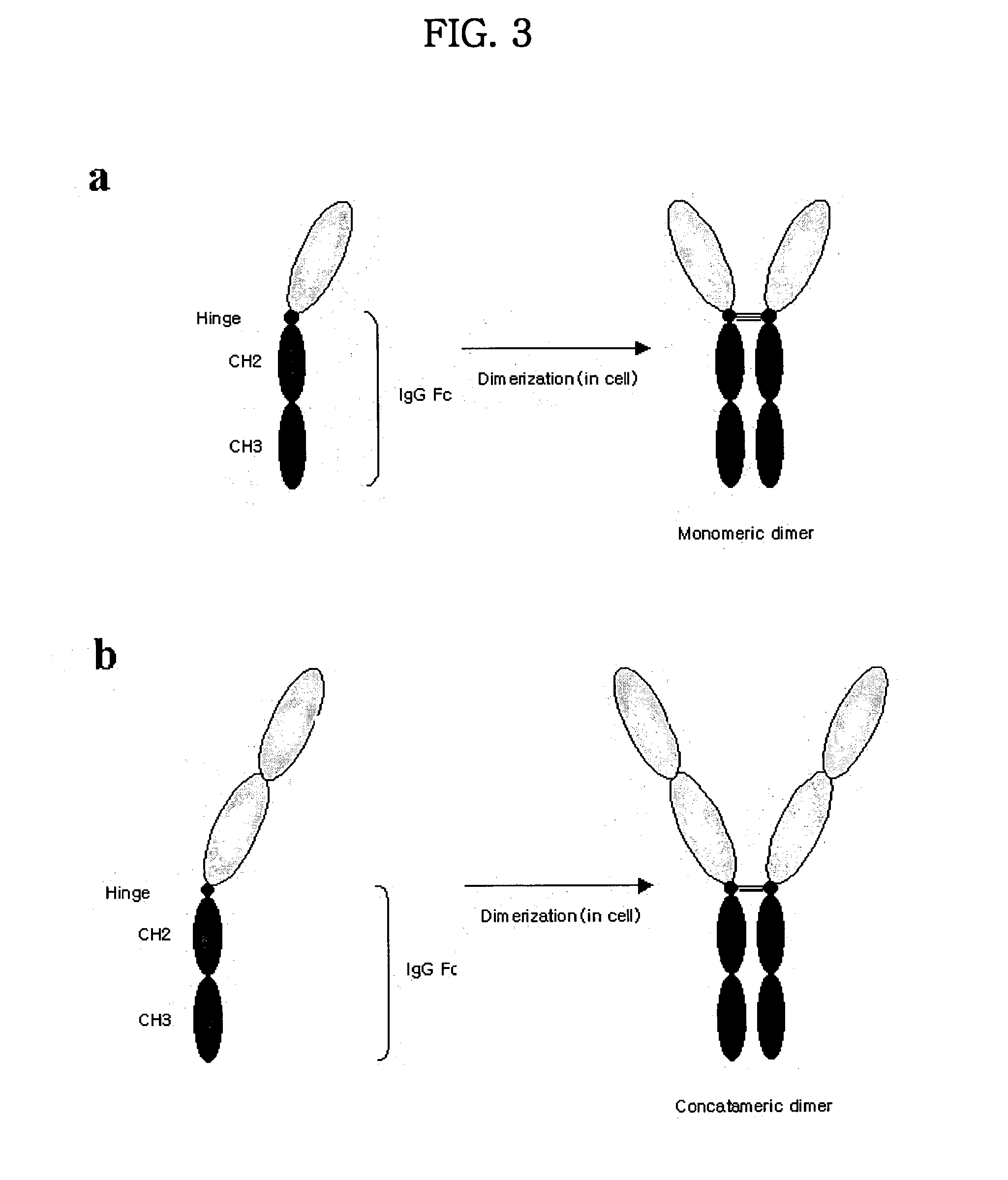Concatameric immunoadhesion
a technology of immunoadhesion and catalytic molecules, applied in the field of catalytic immunoadhesion, can solve the problems of reducing the production yield of multimeric forms, unable to bind to light chains, and difficulty in purifying multimeric high molecular weight forms, etc., and achieves the effect of increasing efficacy and stability
- Summary
- Abstract
- Description
- Claims
- Application Information
AI Technical Summary
Benefits of technology
Problems solved by technology
Method used
Image
Examples
example 2 and 3
CD2 and CTLA4
[0159] DNA fragments encoding soluble extracellular domain of CD2 and CTLA4 were constructed by PCR using a primer [CD2(the sequence of nucleotide of SEQ ID NO: 40), and CTLA4(the sequence of nucleotide of SEQ ID NO: 43)] with EcoRI restriction site and the coding sequence [CD2 (the sequence of nucleotide of SEQ ID NO: 13), and CTLA4 (the sequence of nucleotide of SEQ ID NO: 15)] encoding the leader sequence [CD2(the sequence of amino acid 1-24 of SEQ ID NO: 14), and CTLA4(the sequence of amino acid 1-21 of SEQ ID NO: 16)], and an antisense primer [CD2(the sequence of nucleotide of SEQ ID NO: 41), and CTLA4(the sequence of nucleotide of SEQ ID NO: 44)] with PstI restriction site and the sequence [CD2(the sequence of nucleotide of SEQ ID NO: 13), and CTLA4(the sequence of nucleotide of SEQ ID NO: 15)] encoding 3' end of the soluble extracellular domain of the proteins as described above. The template cDNA for this reaction was constructed by reverse transcription PCR (RT...
example 4
Expression and Purification of Simple / Concatameric Fusion Dimeric Protein of TNFR / Fc
[0171] In order to express the fusion proteins in CHO-K1 cell (ATCC CCL-61, Ovary, Chinese hamster, Cricetulus griseus), after pBluescript KS II (+) plasmid DNA including TNFR / Fc fusion gene was purified from transformed E. coli, an animal cell expression vectors were constructed as TNFR / Fc fragment produced by restriction using EcoRI and XbaI was inserted at EcoRI / XbaI site of an animal cell expression vector, pCR.TM.3 (Invitrogen, USA) plasmid. And these were designated plasmid pTR11-Top10' and plasmid pTR22-Top10', and deposited as accession numbers of KCCM 10288 and KCCM 10291, respectively, at Korean Culture Center of Microorganisms (KCCM) on Jul. 10. 2001.
[0172] Transfection was performed by mixing either the plasmid pTR11-Top10' or plasmid pTR22-Top10' DNA including TNFR / Fc fusion genes as described above with the reagent of Lipofectamin.TM. (Gibco BRL, USA). CHO-K1 cells with the concentratio...
example 5
SDS-PAGE of Purified TNFR1-TNFR1 / Fc and TNFR2-TNFR2 / Fc (FIG. 15)
[0176] Proteins purified using protein A column were electrophorized by the method of SDS-PAGE in reducing condition added by DTT, reducing reagent (which destroy disulfide bond), and in a non-reducing condition excluding DTT. The result of the estimation of molecular weight on SDS-PAGE is shown in Table 10. It was possible to confirm that TNFR / Fc proteins were the shape of a dimer in the cell. The molecular weight deduced from the amino acid sequence of TNFR1-TNFR1-Ig was about 70 kDa, and was estimated as about 102 kDa on SDS-PAGE. As this difference could be regarded as a general phenomenon which generate on the electrophoresis of glycoproteins, this feature seemed to occurr as the result from decrease in mobility on the electrophoresis by the site of glycosylation.
10TABLE 10 Molecular weight of TNFR-TNFR / Fc on the SDS-PAGE. Molecular weight (kDa) Proteins Reducing condition Non-reducing condition TNFR1-TNFR1 / Fc 102 ...
PUM
| Property | Measurement | Unit |
|---|---|---|
| temperature | aaaaa | aaaaa |
| pH | aaaaa | aaaaa |
| pH | aaaaa | aaaaa |
Abstract
Description
Claims
Application Information
 Login to View More
Login to View More - R&D
- Intellectual Property
- Life Sciences
- Materials
- Tech Scout
- Unparalleled Data Quality
- Higher Quality Content
- 60% Fewer Hallucinations
Browse by: Latest US Patents, China's latest patents, Technical Efficacy Thesaurus, Application Domain, Technology Topic, Popular Technical Reports.
© 2025 PatSnap. All rights reserved.Legal|Privacy policy|Modern Slavery Act Transparency Statement|Sitemap|About US| Contact US: help@patsnap.com



